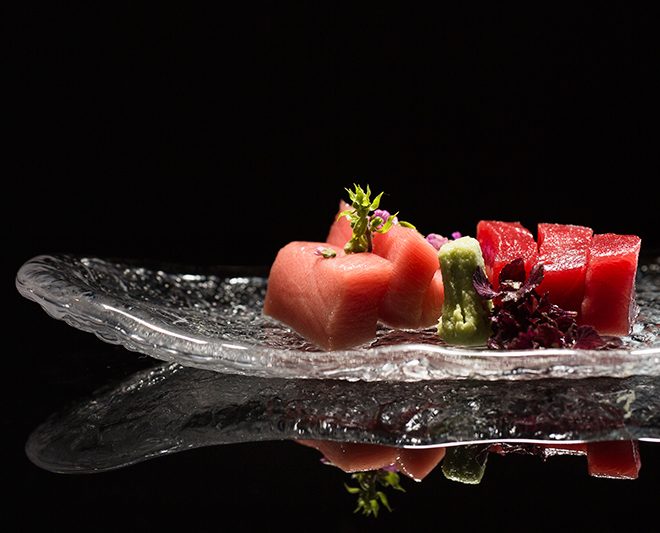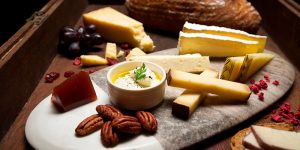Degustation: 3 Chefs Talk Creativity, Cuisine
The art of degustation is one of innovation and creativity. Join us as we speak to three renowned chefs in Singapore and deconstruct the concept.

Imagine sitting in a restaurant and savouring five to 10 exquisitely prepared dishes over a period of three or more hours. You get to taste the food on your palate, relish the visual spectacle on the plate, and indulge in the freshness of the produce and surprising combinations of flavour. These, combined with immaculate table service, are all part of the degustation experience. But what is degustation, really? Originating from the French word “dégustation”, the culinary term refers to a careful, appreciative tasting of various foods that focus on the gustatory (taste) system, the senses, high culinary art, and, of course, good company.
A degustation often involves the sampling of small portions of a chef’s signature dishes in one sitting. It usually begins with the lightest dishes that segue into heavier ones. In between, slightly acidic dishes such as sorbet act as palate cleansers. Cocktails and wines are also an important component of a degustation menu and are suggested as accompaniments to certain dishes.
This is a form of art and science that requires a chef to have an innate sense of gastronomical aesthetics and a knowledge of sophisticated culinary techniques, reflecting the chef’s creativity and innovation, and his or her propensity to induce a sense of curiosity and surprise in the diner.
Yoshiyuki Kashiwabara, Kaiseki Yoshiyuki
Japan has its own version of degustation in the form of kaiseki. One of the highest degrees of culinary art in Japan, this traditional Japanese multi-course haute cuisine was derived from 16th century tea ceremony rituals in Kyoto. And no one knows it better than award-winning chef Yoshiyuki Kashiwabara, who spent seven years as the personal chef to Japanese ambassadors based in San Francisco and Singapore. According to Yoshiyuki – whose résumé includes a stint at the esteemed Kyoryori Hosoi in Tokyo, where he joined as a trainee and eventually headed the kitchen – the essence of kaiseki is an emphasis on natural flavours, a balance of taste and texture, and delicate presentation.
What inspires your kaiseki menu?
Japan’s four seasons and the finest ingredients each season has to offer. For example, I will only use the chestnut in autumn – when it is at its freshest – and not in spring. When it comes to presentation, I will plate the dish with flowers and birds symbolic of a particular season.

Kaiseki Yoshiyuki Interior
What does your kaiseki menu include?
We have a seven-, eight- or nine-course kaiseki menu. For the latter, I create it on the day itself with the freshest and most refined ingredients available that day. It is done in the style of Omakase, which refers to a meal consisting of dishes that are selected by the chef – so it’s up to me. For the other menus, I start with Hassun which features the best vegetables of that season in the form of small appetisers. This is followed by Suimono, a soup with light broth. After this comes Tsukuri, which features sashimi such as akami (tuna) – also known as maguro – and chutoro, a fattier version of akami. Chutoro, or tuna belly, is a premium part of the tuna. When it’s fresh, its taste is unbeatable. I usually served it as small, sliced cubes so that it is not too rich for the palate.
How do you get your fresh produce?
Every morning at 1am, I call the suppliers from Tsukiji market, the largest fish market in Japan, to check what’s available that day. Sometimes, I fly to Japan to select the freshest ingredients in season and deal with suppliers directly, and have the ingredients flown in to the restaurant at least twice a week. If there’s an unforeseen circumstance (such as when a typhoon in Japan affects the produce), I will have to improvise and think of something different for the menu.

Hassun (seasonal vegetables appetiser) that features Japan’s spring
Taste, texture and presentation – how important are
these factors?
Creating subtle, fresh tastes, light textures and intricate food presentation is key. Whether it’s the thought process, the act of cooking or the presentation, it is of utmost importance to pay great attention to detail. Also, all the flavours have to be balanced and reflect the seasonal theme of the dish.
To what extent is kaiseki a form of art and showcase of technique?
Kaiseki cuisine requires a lot of patience, cooking and skilful knife techniques, especially when it comes to carving birds and flowers out of real food and plating them. I have a personal set of knives – they are my tools. A knife is very important to a chef, just like a brush is to a painter. In fact, the way you slice a fish can change its taste and texture.

Daikon (mild flavored winter radish) with crab
In three words, describe your brand of kaiseki.
Poetic, beautiful and pure.
What kind of kaiseki experience do you want diners to have at your restaurant?
I want them to feel good and healthy while tasting the freshest seasonal ingredients, all of which have high nutritional value. And I want to bring them on a journey of Japan’s four seasons through the ingredients and the beauty of the dishes; I want to transport them from Singapore to Kyoto.
Ryan Clift, Tippling Club
Over the course of his 23-year career, Wiltshire-born Ryan Clift has worked with some of the world’s finest chefs, including Marco-Pierre White, Peter Gordon, Emmanuel Renaut, Shannon Bennett and Raymond Capaldi. In 1999, Clift was ran the show in the kitchen at Vue de Monde, one of Australia’s most acclaimed restaurants.
What is your concept of degustation?
I believe that customers need a level of trust in the chef in order to select the degustation option for a meal. For me, it allows us to be truly creative – with the flexibility to select the freshest produce that may only be available on a particular day, or to create something special for a customer.

Snow Crab
How important are taste, texture and presentation?
For me, taste and texture take precedence over presentation. Taste is always the most crucial factor, while textures make the dish that much more exciting and memorable for the diner. Presentation, for us, is based on coming up with the best way to showcase the ingredients and it’s quite fluid – we’re not sticklers for that.
What inspires your degustation menu?
Our latest menu reflects the kitchen team’s travels around the world, particularly Tokyo. The ingredients that we discover on our trips abroad constantly inspire us and we want to share that with our customers and introduce them to unique flavour profiles.

Mangalica Pork Collar
What are some of the highlights of this new menu?
We’ve got a number of really interesting dishes such as the Mangalica Pork Collar, where we brine the meat, then slow cook it for 19 hours at 72 degrees for fork-tender texture. It’s served with cinnamon-infused dashi broth, vegetables pickled in nuka (Japanese rice bran) and nori crackers – all made in-house.
The lobster menu is a really delicate dish of lobster from Brittany served with horseradish, chive gel and, for contrast, a puree of sea buckthorn for some acidity. We then pair it with the Daruma-Mazuma cocktail, which contains lime and lemon that reflect the acidity of the dish.
Our Snow Crab features a refreshing delicate crab salad made from Western Australian crab topped with sliced Kyoho grapes from the Yamanashi prefecture in Japan. It’s all about showcasing the best produce we can find and create matches that really excite the customers’ taste buds.
What kind of experience do you want guests to have with your degustation menu?
I believe everyone has his or her own unique experience. For me, I do not want my guests to feel like they’re in a stiff, formal restaurant, but rather, in a place that’s fun – with damn good food!
Kirk Westaway, Jaan

Kirk Westaway
Growing up in Devon, England surrounded by farm-fresh produce, Westaway’s passion for only the most excellent ingredients is evident in his gastronomic creations. Recently promoted to Chef de Cuisine of Jaan, the 29-year-old spent a term at two-Michelin-starred The Greenhouse in London’s Mayfair. Last February, he was crowned the South East Asian regional winner in the semi-finals of the inaugural S. Pellegrino Young Chef 2015 competition.
What inspires your degustation menu?
Ingredients are what inspire me, they change all the time depending on what produce is at peak. We have five to seven courses that are set and printed daily, depending on the availability I get that day from each fish, meat and vegetable.
The 10-course, being the inspirational menu, is not printed – I create the dishes on the spot before they come in and as they go along during the dining experience, depending on availability. For example, I might have live lobster from Scotland, but that could change to a different fish or meat according to how many dishes are served that night.
I am open to ideas. I talk to diners and listen to their feedback. I value their opinions; sometimes, they inspire me.
What is your most intricate dish?
The Tomato Collection – it’s fresh, clean, sweet and savoury, and has a smooth texture. It is a tomato within a tomato. Firstly, we hollow out the centre of the vine-ripened tomato, semi-dry the part that is taken out overnight, chop it up and add some fresh shallots, parmesan, capers, smoked olive oil and other good ingredients, and stuff them back inside the vine tomatoes. It takes 16 hours for them to dry. We also make some tomato water, add basil sorbet and croutons for crunch. People think they are just looking at a tomato, but when they slice it open, they see all work that goes into it.
In what sequence are the dishes presented?
Step by step, from warm to dense and complex. The menu usually starts off with a Langoustine Cannelloni dish served ice cold. The next dish is served at room temperature – one example is the Tomato Collection. This is followed by an egg that’s served at 55 degrees, then fish with a hot sauce right off the stove. I always finish off with meat and then a palate cleanser before dessert.

Langoustine Cannelloni
How much emphasis do you place on presentation?
My main focus is on taste but I try to make every plate pretty as well; my style of presenting is clean, tidy and elegant. I like to put interesting items on each plate. Colour is important – I generally finish plating dishes with fresh and unique green herbs, and flowers, such as fennel blossom, garlic flowers or carrot flowers – all of which you might not see locally.
How do you come up with all the combinations of flavours and textures in your degustation menu?
We have many ingredients, all of which become different components in each dish. Each flavour serves a purpose, and complements another. For example, when I cook a meat with a sauce, and it works, I’ll leave it. But if I think it needs something interesting, a bit of richness, a bit of crunch, a bit of acidity or sweetness, then I’ll add ingredients accordingly. But if I taste the dish and I feel that one of the elements is not needed, I’ll take it out straight away.

Tomato Collection
What sort of experience do you want diners to have?
I want to create memories and evoke emotions. The menu might look simple, but when the food comes, diners are impressed by how intricate the dishes are. They get to taste fresh organic vegetables, fine cheese and flavoursome quality products from around the world. It’s not just a meal to fill your stomach, but also a multi-sensory experience put together by the culinary team.
Story Credits
Text by Abigail Chia
This story was first published in L’Officiel Singapore.









